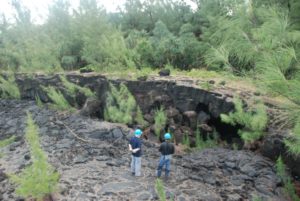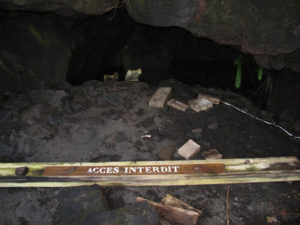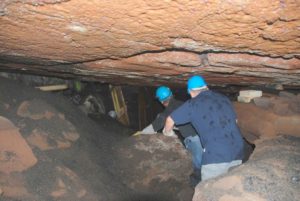Three “treasure hunters” trying to dig close to rock markings in a Réunion cave since December 2015 have been arrested. There’s a short news story here with three nice pictures showing the cave in question:-
And here’s another news story (also in French, but with some talking heads from the local community in a two-minute video at the top of the page).
Inevitably, though, the coverage quickly gets confused: was it Nageon de l’Estang’s or La Buse’s treasure that these treasure hunters were after? (Hint: there’s currently no obvious evidence to support either scenario, but since when has a lack of evidence ever got in the way of greedy self-destructive idiots with shovels?)
And Emmanuel Mezino gets quoted along the way in this final news piece, which I began to translate but then thought better of it.
Why did I stop? Because it’s all so futile: everything to do with the cocked-up cryptograms, the wobbly markings and the diggers’ drooling dreams of gold, gold, gold, all of it. It’s as if everyone involved has a deluded version of the X-Files tag-line tattooed backwards on their forehead to see in the mirror every morning – not so much “I want to believe” as “I have to believe”.
There is no rationality to it all, just trails of zeroes preceded by a mythical non-zero digit and a dollar sign. Evidence, careful history, sound judgment – you’ll search these caves in vain for any of those three too. My best advice: steer your ship well clear of these rocks.



“There is no rationality to it all, just trails of zeroes preceded by a mythical non-zero digit and a dollar sign. Evidence, careful history, sound judgment – you’ll search … in vain for any of those.”
The same might have been, and probably was said by the academic establishment about Schleimann’s activities before it produced gold.
One of the fascinating aspects of studying histories, past and present is how very often the carefully-constructed, and internally-consistent, logical judgements turn out to be utterly wrong, chiefly as a result of never questioning initial premises. I particularly enjoy reading the confident assertions made by central European and English historians of the eighteenth and nineteenth centuries. A constant caution and retrospective amusement.
Or do you regret having published so much about these ciphers? Do you think they encourage the universal desire for improved personal circumstances?
Diane: in my blog, I try to provide if not an antidote then certainly a counterbalance to the prevailing tide of irrationality, pseudoscience and pseudohistory that continues to be passed off as historical cipher “research”: and in that respect, I “regret” not a word.
I have the feeling that for many involved in online ‘research’ even treasure-hunters, it is not so much the research which interests, but the forming of a virtual club.
In a way, then, it becomes a slight disappointment, for some I suppose, rather than being a feeling of success, when a cipher is solved or an historical question resolved.
I suppose multi-player online games have their popularity from something of the same need. I find such things curious, but then I’ve never much liked the scent of team-spirit.
I wasn’t suggesting that you had encouraged treasure-seekers, only that you might have had second thoughts about paying the subject any attention at all.
Diane: at a point in time when three of Google’s top ten hits for “Voynich” point to Stephen Bax’s flailingly failed attempt at decryption, there has surely never been more need for an effective antidote to bad research. At least treasure hunters tend to have some kind of vague awareness that their hopeful theory might actually be wrong. :-/
Diane: as far as the smell of team spirit goes, I think the recent collective cracking of the Paris 7272 cipher was a reasonably good example of how collaboration can genuinely advance research.
Hello,
I am new to this story and what I have read so far has been absolutely fascinating. But your wording on this post has lead me to read that you are giving up on this story?
I know that you and Emmanuel Mezino have had some comment debates and that you pretty much stand at polar opposites to this whole riddle but the challenge of each other’s ideas to me is essential, whether it gets a bit heated or not. I don’t know who is right and who is wrong… But i do know that it has made me want to delve deeper into the mystery, to read his book, your articles and the books you both talk about.
I do hope that you continue to talk about this mystery, it is by far my favourite that I have come across.
James
James Parrish: though Manu is a nice guy, he seems to have been taken in by the mystique of the second version of the cryptogram, which I’m pretty sure is a fake. 🙁
At the same time, the first version of the cryptogram (as carefully copied down by Charles de la Roncière) doesn’t seem to make any real linguistic sense, so that has its own set of practical problems, which Manu never genuinely took on in his book. And trying to stitch this wobbly cryptogram to an (unsourced) pirate legend wasn’t exactly de la Roncière’s best piece of marine history, let’s say. *sigh*
Even so, there’s still lots of work to be done concerning the Nageon de l’Estang pirate treasure mystery (which I’ve already written plenty about, including a post today), which does seem to be built on something real, even if we’re all too blind and stupid to work out what that something real actually was. 😉